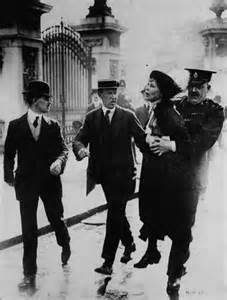Whatever Happened to the Suffragettes Leader. Emmeline Pankhurst?

Emmeline Pankhurst.
In our modern world sexual equality is accepted as the norm in the western world and rightly so. When we consider the battles for this equality we think in the UK of the suffragettes. These women were reviled by backward thinking men and rallied to by forward thinking women. The suffragettes were attacked and jailed for their belief in equality often imprisoned for their beliefs hunger strikes and forced feeding was common. It has to be said that some of the women did indeed commit violent acts when explosives were used on more than one occasion. The leader of the suffragettes was the redoubtable Emmeline Pankhurst. Emmeline was the leader of the suffragette movement in the United Kingdom, she was a feminist and a vociferous supporter of womens rights. In 1908 she chained herself to railings in London to draw more attention to her cause. Through her efforts along with the efforts of her supporters she gained the right for women to vote in the UK.
Emmeline. Her background.
Born Emmeline Goulden in 1858, she lived a comfortable life in Chorlton-on -Medlock, a Manchester suburb. She had an early introduction to feminism, when her mother Sophia Crane used to take her to suffragette meetings in the 1870s. Her father Robert Goulden was also an early supporter of the right for women to vote.
Marriage and politics.
Emmeline usually known as Emily, met and married the barrister Richard Pankhurst who was also a supporter of women's rights. They had five children over ten years. With her husbands support Emily became involved with The Women's Franchise League, a group which advocated womens sufferage. Sadly Richard died in 1898 from a perforated ulcer, so Emily took employment as a local registrar of Births, Marriages and Deaths. In this post she was even more aware of the inequalities of life and the plight of women less fortunate than herself. She became more frustrated at the lack of progress in women's suffrage and in 1903 she founded the Women's Social and Political Union. WSPU, the union grew as she gained publicity but still progress was slow. In 1907 Emily decided that things had to change. She moved to London.
London politics and prison.
The WSPU held meeting and rallys all over the capital on a regular basis and it gained a reputation for militancy. In 1908 Emily was arrested, she had a petition in hand and tried to force her way into the house of commons demanding to see the prime minister. For her pains she spent six weeks in prison. By now she was becoming a public figure and gained more publicity from this imprisonment. She and her supporters devised many publicity stunts and campaigns. Throughout this period Emily was arrested another seven times. At one political rally held in Hyde Park, the WSPU attracted an estimated half a million supporters. A popular method of gaining publicity was for supporters to chain themselves to railings. One woman attended a race meeting and during a race ran in front of the runners in an attempt to stop the King's horse which was in the race. This unfortunate woman who was named Emily Davison was killed in the process. Other women became violent at other venues and women prisoners went on hunger strikes. Some support was lost as violent incidents increased and things were toned down as it became clear that war was not far away.
The first world war.
On the outbreak of The First World War in 1914, all campaigns ceased and all imprisoned suffragettes were released. It was during 1914 that Emily published her autobiography, '' My Own Story '' Throughout the war years Emily campaigned for more involvement of women to help the war effort, with limited effect. Immediately after the war in 1918 the government granted limited women's sufferage. ( the right to vote ) This meant that only women over the age of 30 were allowed to vote. In 1929 this was changed and full voting rights were given to women below the age of 30. By now Emily had transformed the WSPU into the Women's Party. Under this banner she campaigned for equal opportunities for women and became an accepted public figure. She had a strong social concience and was always aware of social injustice. Emily was now living in a nursing home in Hampstead, London. She died there on Thursday, June 14th 1928. Today in the UK we accept as normal the rights of all qualifying citizens to vote. We should not forget this woman of courage and all her supporters, some of whom gave their freedom whilst Emily Davison gave her life.
Emmelines' original home.
The original house in what was Nelson street is now incorporated into the grounds of the extended Manchester Royal Infirmary. There is a plaque outside with much information. The house can be visited by arrangement and many visitors to the Hospital are surprised to find a little gem of history as they make their way through the grounds.
Significant Men: Arthur Ransome. Swallows Amazons and a Secret Life.
edit Facts About The Jarrow March : The Need for Employment.
© 2012 Graham Lee



